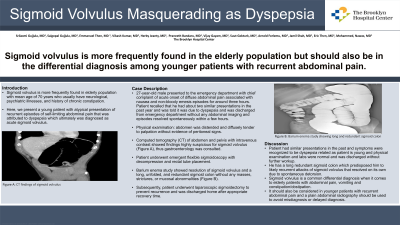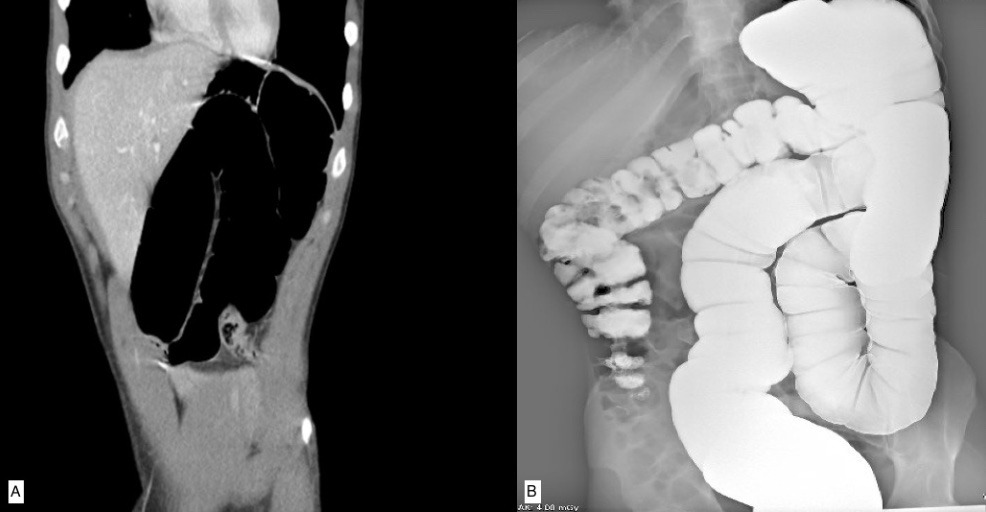Monday Poster Session
Category: Colon
P1691 - Sigmoid Volvulus Masquerading as Dyspepsia
Monday, October 23, 2023
10:30 AM - 4:15 PM PT
Location: Exhibit Hall

Has Audio
- SG
Srilaxmi Gujjula, MD
Brooklyn Hospital Center
Brooklyn, New York
Presenting Author(s)
Srilaxmi Gujjula, MD1, Saigopal R. Gujjula, 2, Enmanuel Then, 3, Vikash Kumar, MD1, Herby Jeanty, MD1, Praneeth Bandaru, MD1, Vijay Gayam, MD1, Suut Gokturk, MD4, Arnold Forlemu, MD, MPH1, Jamil Shah, MD1, Eric Then, MD1, Mohammad Nawaz, MD1
1Brooklyn Hospital Center, Brooklyn, NY; 2American University of Antigua, Coolidge, Saint John, Antigua and Barbuda; 3Universidad Iberoamericana, Gazcue, Distrito Nacional, Dominican Republic; 4SBH, Cheshire, CT
Introduction: Sigmoid volvulus is more frequently found in elderly population with mean age of 70 years who usually have neurological, psychiatric illnesses, and history of chronic constipation. Here, we present a young patient with atypical presentation of recurrent episodes of self-limiting abdominal pain that was attributed to dyspepsia which ultimately was diagnosed as acute sigmoid volvulus.
Case Description/Methods: 27-year-old male presented to the emergency department with chief complaint of acute onset of diffuse abdominal pain associated with nausea and non-bloody emesis episodes for around three hours. He reported having a bowel movement around 12 hours prior to the onset of pain. Patient recalled that he had about two similar presentations in the past year and was told it was due to dyspepsia and was discharged from emergency department without any abdominal imaging and episodes resolved spontaneously within a few hours. On physical examination, abdomen was distended and diffusely tender to palpation without evidence of peritoneal signs. Computed tomography (CT) of abdomen and pelvis with intravenous contrast showed findings highly suspicious for sigmoid volvulus (Figure A), thus gastroenterology was consulted. Patient underwent emergent flexible sigmoidoscopy with decompression and rectal tube placement. Barium enema study showed resolution of sigmoid volvulus and a long, unfolded, and redundant sigmoid colon without any masses, strictures, or mucosal abnormalities (Figure B). Subsequently, patient underwent laparoscopic sigmoidectomy to prevent recurrence and was discharged home after appropriate recovery time.
Discussion: Patient had similar presentations in the past and symptoms were recognized to be dyspepsia related due to patient's young age and normal physical examination and lab findings and was discharged without further workup. He has a long redundant sigmoid colon which predisposed him to likely recurrent attacks of sigmoid volvulus that resolved on its own due to spontaneous detorsion. Sigmoid volvulus is a common differential diagnosis when it comes to elderly patients with abdominal pain, vomiting and constipation/obstipation. It should also be considered in younger patients with recurrent abdominal pain, and a plain abdominal radiography should be used to prevent misdiagnosis or delayed diagnosis.

Disclosures:
Srilaxmi Gujjula, MD1, Saigopal R. Gujjula, 2, Enmanuel Then, 3, Vikash Kumar, MD1, Herby Jeanty, MD1, Praneeth Bandaru, MD1, Vijay Gayam, MD1, Suut Gokturk, MD4, Arnold Forlemu, MD, MPH1, Jamil Shah, MD1, Eric Then, MD1, Mohammad Nawaz, MD1. P1691 - Sigmoid Volvulus Masquerading as Dyspepsia, ACG 2023 Annual Scientific Meeting Abstracts. Vancouver, BC, Canada: American College of Gastroenterology.
1Brooklyn Hospital Center, Brooklyn, NY; 2American University of Antigua, Coolidge, Saint John, Antigua and Barbuda; 3Universidad Iberoamericana, Gazcue, Distrito Nacional, Dominican Republic; 4SBH, Cheshire, CT
Introduction: Sigmoid volvulus is more frequently found in elderly population with mean age of 70 years who usually have neurological, psychiatric illnesses, and history of chronic constipation. Here, we present a young patient with atypical presentation of recurrent episodes of self-limiting abdominal pain that was attributed to dyspepsia which ultimately was diagnosed as acute sigmoid volvulus.
Case Description/Methods: 27-year-old male presented to the emergency department with chief complaint of acute onset of diffuse abdominal pain associated with nausea and non-bloody emesis episodes for around three hours. He reported having a bowel movement around 12 hours prior to the onset of pain. Patient recalled that he had about two similar presentations in the past year and was told it was due to dyspepsia and was discharged from emergency department without any abdominal imaging and episodes resolved spontaneously within a few hours. On physical examination, abdomen was distended and diffusely tender to palpation without evidence of peritoneal signs. Computed tomography (CT) of abdomen and pelvis with intravenous contrast showed findings highly suspicious for sigmoid volvulus (Figure A), thus gastroenterology was consulted. Patient underwent emergent flexible sigmoidoscopy with decompression and rectal tube placement. Barium enema study showed resolution of sigmoid volvulus and a long, unfolded, and redundant sigmoid colon without any masses, strictures, or mucosal abnormalities (Figure B). Subsequently, patient underwent laparoscopic sigmoidectomy to prevent recurrence and was discharged home after appropriate recovery time.
Discussion: Patient had similar presentations in the past and symptoms were recognized to be dyspepsia related due to patient's young age and normal physical examination and lab findings and was discharged without further workup. He has a long redundant sigmoid colon which predisposed him to likely recurrent attacks of sigmoid volvulus that resolved on its own due to spontaneous detorsion. Sigmoid volvulus is a common differential diagnosis when it comes to elderly patients with abdominal pain, vomiting and constipation/obstipation. It should also be considered in younger patients with recurrent abdominal pain, and a plain abdominal radiography should be used to prevent misdiagnosis or delayed diagnosis.

Figure: Figure A: CT findings of sigmoid volvulus
Figure B: Barium enema study showing long and redundant sigmoid colon
Figure B: Barium enema study showing long and redundant sigmoid colon
Disclosures:
Srilaxmi Gujjula indicated no relevant financial relationships.
Saigopal Gujjula indicated no relevant financial relationships.
Enmanuel Then indicated no relevant financial relationships.
Vikash Kumar indicated no relevant financial relationships.
Herby Jeanty indicated no relevant financial relationships.
Praneeth Bandaru indicated no relevant financial relationships.
Vijay Gayam indicated no relevant financial relationships.
Suut Gokturk indicated no relevant financial relationships.
Arnold Forlemu indicated no relevant financial relationships.
Jamil Shah indicated no relevant financial relationships.
Eric Then indicated no relevant financial relationships.
Mohammad Nawaz indicated no relevant financial relationships.
Srilaxmi Gujjula, MD1, Saigopal R. Gujjula, 2, Enmanuel Then, 3, Vikash Kumar, MD1, Herby Jeanty, MD1, Praneeth Bandaru, MD1, Vijay Gayam, MD1, Suut Gokturk, MD4, Arnold Forlemu, MD, MPH1, Jamil Shah, MD1, Eric Then, MD1, Mohammad Nawaz, MD1. P1691 - Sigmoid Volvulus Masquerading as Dyspepsia, ACG 2023 Annual Scientific Meeting Abstracts. Vancouver, BC, Canada: American College of Gastroenterology.
